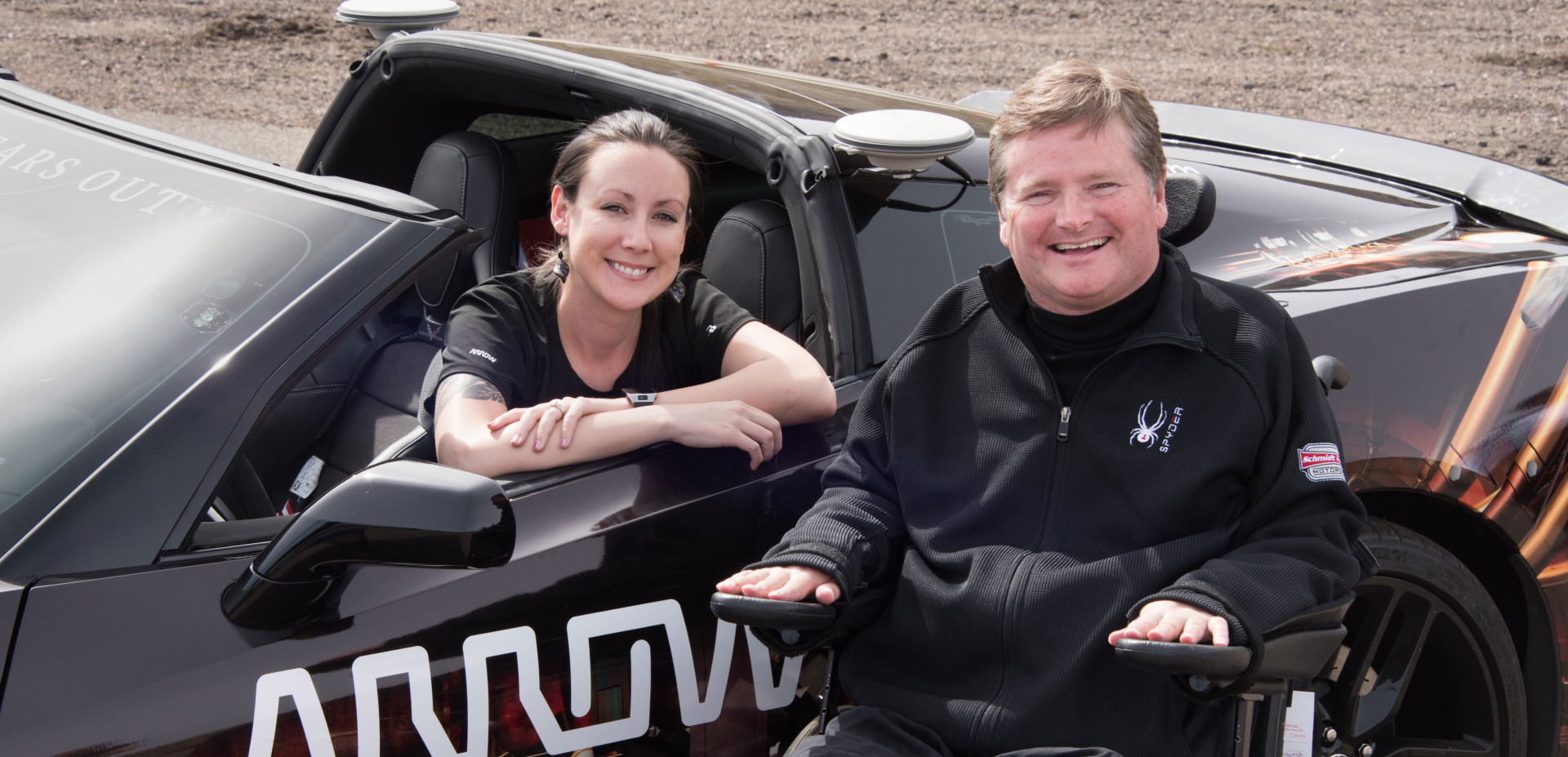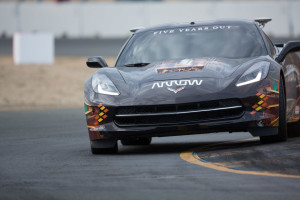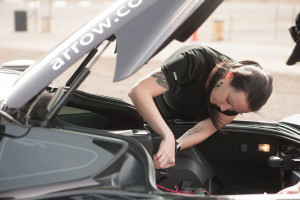
Noel Marshall ’12 and former Indy Racing League driver Sam Schmidt, with the modified SAM car. This photo is featured in a Denver International Airport ad. Credit: Arrow Electronics
For as long as she can remember, Noel Marshall was intrigued by the sound of a car engine.
Her father had a first-generation Acura Integra. He’d let her hold the wheel and steer sometimes, and she loved revving the engine, when he let her. Soon, she was learning how to change a tire, change the oil, peer under the hood. “I don’t know why; I just liked it,” she says.

That, and an early penchant for math, planted the seed for Marshall to get her degree in mechanical engineering from Colorado State University in 2012. Now an applications engineer at Centennial-based Arrow Electronics, Marshall has kicked her love of cars into higher gear, in ways she never imagined possible.
Marshall is lead engineer for Arrow’s team that’s attracted worldwide attention for an unusual project: modification of a 2014 Corvette C7 Stingray to allow a quadriplegic driver to operate it in racetrack conditions. Sam Schmidt is a former Indy Racing League driver who crashed and became paralyzed in 2000. By moving his head and puffing air into a plastic tube, the former racer can drive again. He and the Arrow team debuted the car, which they’ve aptly named SAM (semi-autonomous motorcar), at the 2014 Indianapolis 500.

Marshall is Schmidt’s co-driver. She’s almost always in the right-hand seat with him, as part of a safety integration that allows her to take control, if needed (“We hit a cone once. That was pretty funny,” she says). When not in the passenger seat, Marshall works on systems integration, safety analysis, seating, restraint, computer-aided design simulations, and the thousand other things that go into such a complex piece of engineering.
A historic project
How it all started: Back in 2013, Arrow sent around an email to employees, asking for volunteers to work on a mysterious “race car project.”
“I immediately raised my hand, not even knowing what it was,” Marshall said.
At the first team meeting, it was divulged they’d be doing something very hard, and historic – allowing a paralyzed racer to drive again. And drive fast.
The team had only a few months to get the car working before its debut at the famed Indianapolis Motor Speedway. At the Indy 500, Schmidt performed what’s called a qualifying lap, before thousands of screaming fans. He did six laps total, hitting 80 mph. The next morning, the crowds dispersed, Schmidt said he wanted to drive again. So Marshall and the rest of the Arrow team met him at the track, and he hit about 110 mph. His family was there. Tears were shed.
“That was really awesome,” Marshall said.
The SAM car is just one of the ways Arrow is trying to prove it can do, well, just about anything.
“This was the perfect way to demonstrate our capabilities,” Marshall said. “All the tech that’s in the car is off the shelf, standard stuff. It’s not groundbreaking. But it’s repurposed and integrated in such a way that it’s used for a very different application.”
Marshall interned at Arrow while a CSU student, and that internship turned into a full-time job after graduation. At CSU, she also worked on the EcoCar 2 team, which converted a 2012 Chevrolet Malibu into a plug-in hybrid electric vehicle. And she learned a lot.
“It was my first experience being on such a large team, and it was challenge,” she said.
Things like project management, networking, building relationships with sponsors were all part of EcoCar, not to mention the technical aspects. When she joined the Arrow SAM car team, she brought her experience with 12-volt systems gained at CSU and EcoCar.
“The biggest thing I learned with EcoCar was that if someone says it can’t be done or it shouldn’t be done, that’s when you should pursue it,” Marshall said. “Because it could be groundbreaking. If you push the envelope and push yourself, that’s where the growth happens, and that’s where you learn.”
Noel’s nontraditional path
It’s a can-do attitude that wasn’t always there. Early on, Marshall admits, “I didn’t have my act together.” She originally enrolled at CSU in 2001, but ended up quitting school for a few years, working at Best Buy as an audio install tech. “It was one way to get closer to cars,” she said.
She rematriculated in 2008. “I was like, I’m doing all this hard work and not getting paid. I’m smarter than this, and I know I need to go back to school,” she said. Her parents, who themselves did not attend college, encouraged her. “I told them I wanted to go back and study engineering, and they were excited, and helped me apply,” she said. “They didn’t have money, but they helped me with loans for the first semester.”
Marshall says Terry Comerford, director of CSU’s Engineering Success Center, was the one who “really helped me get back on my feet.”
“I remember her saying, ‘You need to be serious about this. You won’t get a third chance.’” Comerford connected Marshall with the Society of Women Engineers and other resources. Marshall started attending office hours and study groups. She joined the EcoCar team. It was Comerford who pushed her to apply for the internship at Arrow. The rest is history.
The SAM car project continues; the team has recently modified it again to allow Schmidt to drive a road course. That posed extra challenges – hairpin turns, elevation changes – beyond just laps around an oval.
The project recently caught the eye of Gov. John Hickenlooper, who visited Arrow in October and took the car for a (slow) test drive in the parking lot. With Marshall in the passenger seat as usual, she recalled, Hickenlooper placed his hands on the steering wheel, saying, “I’m ready.” Marshall explained that he didn’t need his hands to drive. She laughed. The governor is a good driver, and got the hang of it quickly, Marshall reported.